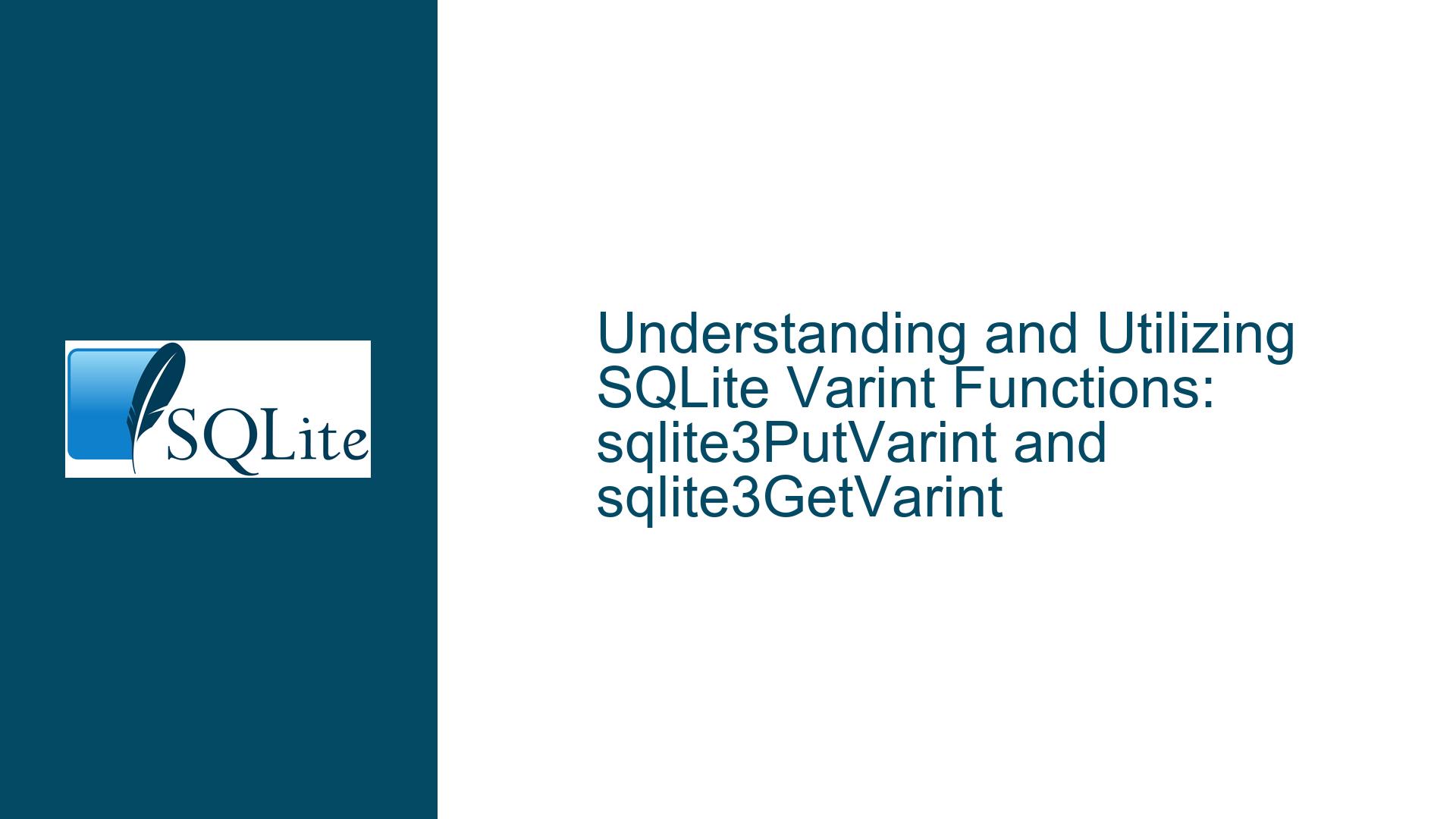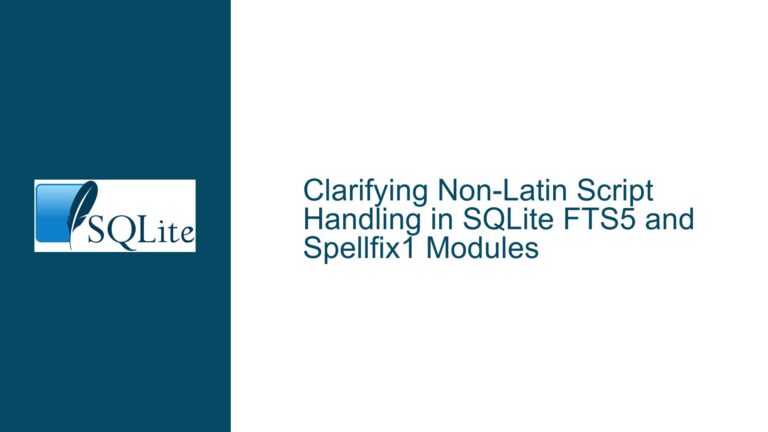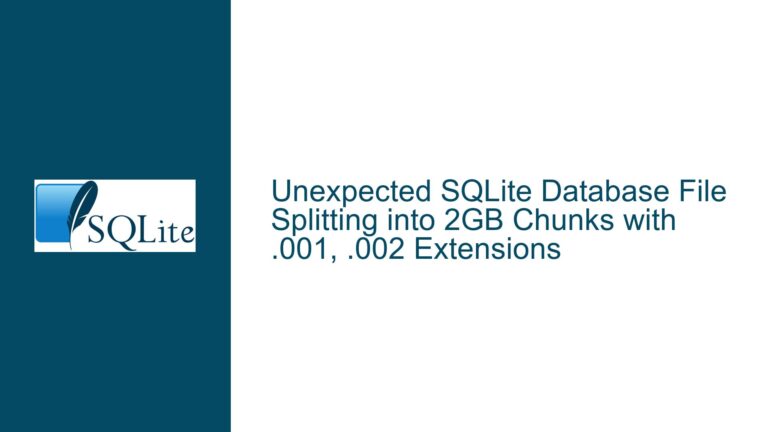and Utilizing SQLite Varint Functions: sqlite3PutVarint and sqlite3GetVarint
Varint Encoding in SQLite and Its Internal Functions
Varint, or variable-length integer encoding, is a method used in SQLite to store integers in a compact form, especially useful for small positive values. The encoding scheme is designed to use between 1 and 9 bytes, depending on the magnitude of the integer. The encoding is a form of Huffman coding, where the high-order bit of each byte indicates whether the next byte is part of the varint. The lower seven bits of each byte (or all eight bits of the ninth byte) are used to reconstruct the original 64-bit twos-complement integer. This encoding is big-endian, meaning that the most significant bits come from the earlier bytes of the varint.
SQLite provides several internal functions and macros to handle varint encoding and decoding, such as sqlite3PutVarint, sqlite3GetVarint, sqlite3GetVarint32, sqlite3VarintLen, getVarint32, getVarint32NR, and putVarint32. These functions are used internally by SQLite to manage the storage and retrieval of varints in the database file format. However, these functions are not part of the public API and are not documented for external use. They are defined with internal linkage, meaning they are only accessible within the SQLite source code and are subject to change without notice.
The sqlite3PutVarint function, for example, is used to encode a 64-bit unsigned integer into a varint format. The function checks the value of the integer and encodes it into 1, 2, or up to 9 bytes, depending on its size. The sqlite3GetVarint function does the reverse, decoding a varint from a byte array back into a 64-bit unsigned integer. These functions are crucial for SQLite’s internal operations but are not intended for use by external applications.
Challenges in Using Undocumented SQLite Varint Functions
The primary challenge in using functions like sqlite3PutVarint and sqlite3GetVarint is that they are not part of SQLite’s public API. This means they are not documented, not guaranteed to be stable across different versions of SQLite, and are not exposed for external use. The functions are defined with internal linkage, meaning they are only accessible within the SQLite source code. This design choice is intentional, as it allows the SQLite developers to refactor and optimize these functions without worrying about breaking external applications that might rely on them.
Another challenge is that these functions are not prefixed with sqlite3_, which is the standard prefix for all public API functions in SQLite. This is a clear indication that these functions are not intended for external use. The lack of external linkage further reinforces this point, as it means that these functions cannot be called from outside the SQLite source code without modifying the SQLite build process.
For developers who wish to use varint encoding in their applications, the recommended approach is to implement their own varint encoding and decoding functions. This approach ensures that the code is portable, stable, and not dependent on the internal implementation details of SQLite. While it may require some additional effort, it is a safer and more maintainable solution in the long run.
Implementing Custom Varint Functions and Best Practices
For developers who need to work with varint encoding, the best approach is to implement custom varint functions based on the varint encoding specification provided in the SQLite file format documentation. The specification describes how varints are encoded and decoded, and it is straightforward to implement these operations in any programming language.
The varint encoding process involves checking the value of the integer and encoding it into a sequence of bytes. For values less than or equal to 0x7F, a single byte is sufficient. For values greater than 0x7F but less than or equal to 0x3FFF, two bytes are used. For larger values, up to nine bytes may be required. The encoding process involves shifting the integer value and masking the lower seven bits of each byte, with the high-order bit set to indicate that the next byte is part of the varint.
The decoding process involves reading the bytes of the varint and reconstructing the original integer value. The high-order bit of each byte is checked to determine if the next byte is part of the varint. The lower seven bits of each byte are combined to reconstruct the integer value. The process continues until a byte with the high-order bit clear is encountered, or until nine bytes have been read.
Here is an example of how to implement custom varint encoding and decoding functions in C:
#include <stdint.h>
#include <stddef.h>
// Function to encode a 64-bit unsigned integer into a varint
size_t putVarint(uint8_t *p, uint64_t v) {
if (v <= 0x7F) {
p[0] = v & 0x7F;
return 1;
}
if (v <= 0x3FFF) {
p[0] = ((v >> 7) & 0x7F) | 0x80;
p[1] = v & 0x7F;
return 2;
}
// Implement the full 9-byte encoding for larger values
size_t len = 0;
while (v > 0x7F) {
p[len++] = (v & 0x7F) | 0x80;
v >>= 7;
}
p[len++] = v & 0x7F;
return len;
}
// Function to decode a varint into a 64-bit unsigned integer
uint64_t getVarint(const uint8_t *p, size_t *len) {
uint64_t v = 0;
size_t shift = 0;
*len = 0;
while (1) {
uint8_t byte = p[(*len)++];
v |= (uint64_t)(byte & 0x7F) << shift;
if ((byte & 0x80) == 0) {
break;
}
shift += 7;
if (shift >= 64) {
// Handle error: varint too large
return 0;
}
}
return v;
}
These functions can be used to encode and decode varints in a way that is compatible with SQLite’s internal varint encoding. By implementing custom varint functions, developers can avoid relying on SQLite’s internal functions and ensure that their code is portable and maintainable.
In addition to implementing custom varint functions, developers should also consider the following best practices:
- Documentation: Clearly document the varint encoding and decoding functions, including the format of the varint and any limitations or edge cases.
- Testing: Thoroughly test the varint functions with a variety of input values, including edge cases such as the maximum 64-bit integer value and values that require the full 9-byte encoding.
- Error Handling: Implement robust error handling to deal with invalid varint encodings, such as varints that are too long or contain invalid bytes.
- Performance: Consider the performance implications of varint encoding and decoding, especially in performance-critical applications. Optimize the functions as needed to minimize overhead.
By following these best practices, developers can ensure that their custom varint functions are reliable, efficient, and compatible with SQLite’s internal varint encoding.
In conclusion, while SQLite provides internal functions for varint encoding and decoding, these functions are not part of the public API and should not be relied upon by external applications. Instead, developers should implement their own varint functions based on the varint encoding specification provided in the SQLite file format documentation. By doing so, they can ensure that their code is portable, stable, and maintainable, while also adhering to best practices for documentation, testing, error handling, and performance.






